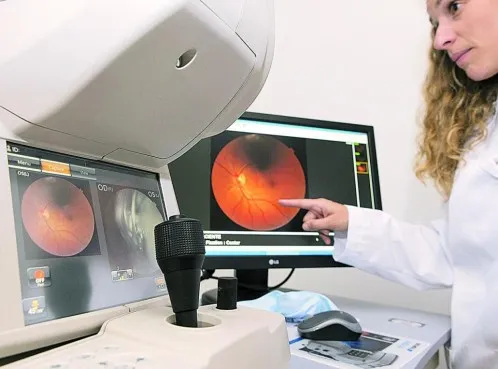On the occasion of World Diabetes Day, the La Milagrosa hospital has joined the set of initiatives carried out throughout the country and has organized an awareness campaign to prevent diabetic retinopathy, one of the main causes of blindness in countriesdeveloped.
In fact, according to Dr. María Capote, a specialist in the treatment of retinal service of the La Milagrosa hospital, the prevalence of diabetic retinotopathy, is 25% in diabetic patients, that is, one in four diabetic patients,It presents some degree of retinopathy.
Diabetic retinopathy is a complication of diabetes and one of the main causes of blindness.It occurs when chronic disease damages small blood vessels in the retina, which is the tissue responsible for transmitting visual information to the brain.
Risk factors of diabetic retinopathy
There are several factors can influence the development and severity of diabetic retinopathy:
-Slong blood sugar levels.A control of them can help delay and control the appearance and progression of the disease.
- Blood pressure.Keeping it controlled reduces the risk of diabetic retinopathy and the deterioration of visual acuity.A high blood pressure damages blood vessels, increasing the possibilities of eyes problems.The ideal blood pressure for most people with diabetes should be less than 130/80 mmHg.
- Duration of diabetes.The risk of developing a diabetic retinopathy or of progressing, increases over time.After 15 years with diabetes, 80% of type 1 diabetics develop diabetic retinopathy.After 20 years, up to 60% of those affected by type 2, also develops the disease.
- levels of lipids in the blood (cholesterol and triglycerides).The high levels of these blood lipids can lead to a greater accumulation of exudates, protein deposits that are filtered in the retina.This condition is associated with a higher risk of moderate visual loss.
-L ethnic origin.Diabetic retinopathy can occur in any person with diabetes, but African Americans, Latinos and Native American are more risky to suffer visual disease because they also have more propensity to develop diabetes.
PregnancyGestation produces changes in vision and can increase the chances of developing the disease and even progressing if it is already suffered.Fortunately, there are data that indicate that these changes can be reversed after giving birth if they are treated and there is no increase in the long -term progression of the disease.
Family history.As in almost all diseases, having a history is an added risk of developing diabetes, and there is convenient ophthalmological reviews to detect retinopathy.
symptoms, better to advance and prevent
Unfortunately, diabetic retinopathy does not offer any early warning signal to alert your presence.For this reason, it is important that patients do not wait to have symptoms and check their view annually.
However, it is important to take into account these signs that can be a warning:
- Blurred vision or double vision
- Files of light, which can indicate an early development of a cataract or alterations in the retina.
-L a veil, cloud, or red stripes in the visual field, or dark or floating spots on one or both eyes, which may indicate bleeding
-Sisy or blank in the visual field
Prevent diabetic retinopathy
Thanks to optical coherence tomography, a reference toe technology for the diagnosis and monitoring ofRetina and optical nerve diseases, through a quick, simple and non -painful exploration, the specialist obtains great information from the most important structures of the eye.
In addition, it allows the test through very narrow pupils, and without the need to throw drops to delay them.
With this technique it is possible to study both superficial and deep structures of the eye: the cornea, the crop angle, the macula, the optical nerve ... its precise results and objectives help in the diagnosis, treatment, monitoring and prevention of ocular diseases.
Treatment of diabetic retinopathy
In all stages of the disease, says Dr. María Capote, the fundamental treatment is to improve metabolic control, controlling blood glucose levels.
In the early stages, only with this strict control, there may be an improvement of the vascular alterations that are detected.
In more advanced stages, there are pharmacological treatment such as antiangiogenic drugs, to avoid the growth and malformation of blood vessels in the retina and anti -inflammatory drugs.This type of treatment sometimes combined with laser therapy, allows the control of the disease, explains the ophthalmologist.Sometimes vitreorretinian surgery is necessary for the most severe cases.
Source: The reason


